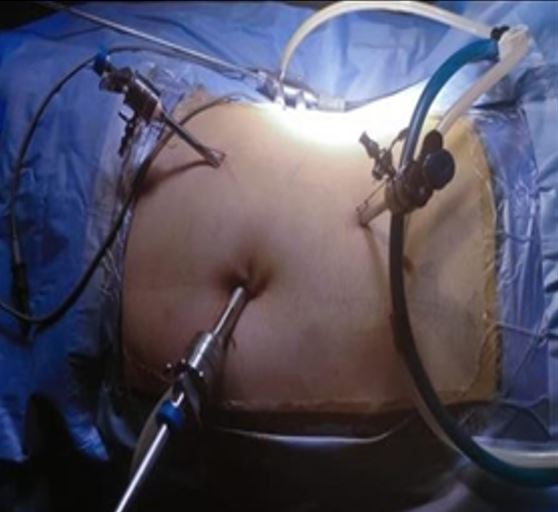Outcome of Different Endoscopic Modalities in Management of Large Proximal Ureteric Stone
Abstract
Background: A urologist inserts a long, thin tube with a camera (ureteroscope) into your urethra (where pee leaves your body). They feed the ureteroscope through your bladder and into your ureter. Once they find your stone, they remove it or break it up with a laser. Percutaneous nephrolithotomy. Various techniques have been documented for the management of Large Proximal Ureteric Stones (LPUS), such as laparoscopy (LUL), antegrade approach, retrograde ureteroscopy (RURS), extracorporeal shockwave lithotripsy, and infrequently open surgery. The paper aimed to compare the overall results of treating patients with large proximal ureteric stones (15-20 mm) using transperitoneal LUL, RURS, and mini-percutaneous antegrade ureteroscopy.
Methods: This prospective, randomized trial involved 100 individuals of both sexes who were above the age of 18 and had a single, 15-20 mm LPUS. Patients were split into two equal groups at random: Group B received RURS combined with laser fragmentation, and Group A received LUL.
Results: 100 patients who were included in the trial were split evenly between the two groups based on similar demographic information and stone criteria. Regarding patient demographics and stone criteria, both groups were similar. Group A had a substantially greater stone-free percentage (100%) than Group B (72%). There was a significant difference (p<0.001) in the operating duration, hemoglobin deficit, and ultimate stone-free rate between groups A and B. There was little difference in the two groups' conversation rates, mucosal injuries, ureteral perforations, complications, and length of hospital stay.
Conclusions: Compared to RURS, LUL is linked to a greater stone-free rate and fewer complications.
Downloads
References
2. Bahar SHM, Amirhassani S, Nouralizadeh A, Jou ZN, Rasiuli J. Percutaneous nephrolithotomy versus laparoscopy in the management of large proximal ureteral stones: The experience of two different settings. Urological Journal. 2019; 16:448-452.
3. Preminger GM, Tiselius HG, Assimos DG, Alken P, Buck C, Gallucci M, et al. 2007 guideline for the management of ureteral calculi. Urological Journal. 2007; 178:2418-434.
4. Kijvikai K, Haleblian GE, Preminger GM, de la Rosette J. Shock wave lithotripsy or ureteroscopy for the management of proximal ureteral calculi: An old discussion revisited. Urological Journal. 2007; 178:1157- 1163.
5. Elashry OM, Tawfik AM. Preventing stone retropulsion during intracorporeal lithotripsy. Nature Reviews Urology. 2012; 90:691-698.
6. Chow GK, Patterson DE, Blute ML, Segura JW. Ureteroscopy: Effect of technology and technique on clinical practice. Urological Journal. 2003; 170:99-102.
7. Cohen J, Cohen S, Grasso M. Ureteropyeloscopic treatment of large, complex intrarenal and proximal ureteral calculi. BJU International. 2013; 111:127-131.
8. Kaygısız O, Coşkun B, Kılıçarslan H, Kordan Y, Vuruşkan H, Özmerdiven G, et al. Comparison of ureteroscopic laser lithotripsy with laparoscopic ureterolithotomy for large proximal and mid-ureter stones. Urological International. 2015; 94:205-209.
9. Boonstra AM, Preuper HRS, Balk GA, Stewart RE. Cut-off points for mild, moderate, and severe pain on the visual analogue scale for pain in patients with chronic musculoskeletal pain. Pain. 2014; 155:2545- 2550.
10. Dindo D, Demartines N, Clavien PA. Classification of surgical complications: A new proposal with evaluation in a cohort of 6336 patients and results of a survey. Annals of Surgery. 2004; 240:205-213.
11. Preminger GM, Tiselius HG, Assimos DG, Alken P, Buck C, Gallucci M, et al. 2007 guideline for the management of ureteral calculi. Journal of Urology. 2007; 178:2418-2434.
12. Elgebaly O, Abdeldayem H, Idris F, Elrifai A, Fahmy Antegrade mini-percutaneous flexible ureteroscopy versus retrograde ureteroscopy for treating impacted proximal ureteric stones of 1-2 cm: A prospective randomised study. Arab Journal of Urology. 2020; 18:176-180.
13. Kadyan B, Sabale V, Mane D, Satav V, Mulay A, Thakur N, et al. Large proximal ureteral stones: Ideal treatment modality? Urological Annals. 2016; 8:189- 200.
14. Güler Y, Erbin A. Comparative evaluation of retrograde intrarenal surgery, antegrade ureterorenoscopy and laparoscopic ureterolithotomy in the treatment of impacted proximal ureteral stones larger than 1.5 cm. Central European Journal of Urology. 2021; 74:57-59.
15. Basiri A, Simforoosh N, Ziaee A, Shayaninasab H, Moghaddam SMMH, Zare S. Retrograde, antegrade, and laparoscopic approaches for the management of large, proximal ureteral stones: A randomized clinical trial. Journal of Endourology. 2008; 22:2677-80.
16. Kumar A, Vasudeva P, Nanda B, Kumar N, Jha SK, Singh H. A prospective randomized comparison between laparoscopic ureterolithotomy and semi rigid ureteroscopy for upper ureteral stones > 2 cm: A single- center experience. Journal of Endourology. 2015; 29:1248-1252.
17. Abdel Raheem A, Alowidah I, Hagras A, Gameel T, Ghaith A, Elghiaty A, et al. Laparoscopic ureterolithotomy for large proximal ureteric stones: Surgical technique, outcomes and literature review. Asian Journal of Endoscopic Surgery. 2021; 14:241- 249.

Copyright (c) 2025 Author (s). Published by Siddharth Health Research and Social Welfare Society

This work is licensed under a Creative Commons Attribution 4.0 International License.


 OAI - Open Archives Initiative
OAI - Open Archives Initiative


